Chest and Shoulder Pain Stretching Exercises
Shoulder and chest pain when lifting or moving your arms?
Here you'll find stretching exercises for Impingement, Tendinitis and pain from poor posture.
Shoulder and chest pain when lifting or moving your arms?
Here you'll find stretching exercises for Impingement, Tendinitis and pain from poor posture.
Shoulder and chest pain can be not only uncomfortable but also highly disruptive to our daily lives. If you're seeking answers to questions like "Why should I stretch when I have shoulder pain?" or "What's causing my shoulder pain in the first place?", you've come to the right place. Five Muscles is designed to provide you with insights and effective solutions.
By delving into the whys and wherefores of shoulder pain and the profound benefits of targeted stretching exercises, we aim to guide you on a journey toward relief and rejuvenation. Whether your discomfort stems from poor posture, overuse, or muscle tension, our comprehensive approach to stretching exercises will empower you to regain flexibility, reduce pain, and restore comfort to your shoulders and chest. Our stretching program consists of a few simple exercises:
All of those exercises can easily be done at home within a few minutes. It is important to start slowly and gradually increase the intensity of the shoulder and chest pain exercises as your flexibility improves. Follow our program and help your shoulder pain!
CHEST AND SHOULDER PAIN exercises
Are you ready to take control of your shoulder and chest pain? Join me on this journey to relieve discomfort, regain mobility, and rediscover the joy of pain-free living. Together, we'll explore a series of targeted stretches that will empower you to feel your best. Let's start stretching and embrace a life with more flexibility, less pain, and renewed vitality!
Follow Jo's stretching routine on video or set your own pace by using our photo instructions below.
Regular stretching exercises for the shoulders and chest improve the flexibility of the muscles and joints in these areas. This increased flexibility allows for a broader range of motion, making daily activities easier and more comfortable.
As your muscles become more supple, you'll experience less stiffness and reduced tension, leading to a more pain-free and mobile upper body.
Strengthening and stretching the muscles in the shoulders and chest helps correct imbalances caused by poor posture.
Chest and shoulder pain exercises play a pivotal role in preventing chest muscles from shortening and shoulders from pulling forward, ultimately promoting better posture and reducing discomfort.
Regular stretching exercises target the muscles that commonly contribute to shoulder and chest pain. By addressing muscle tension and imbalance, you can experience significant pain reduction and relief.
Stretching helps relax tight muscles, reduces discomfort, and can alleviate chronic pain, allowing you to lead a more pain-free life.
Incorporating shoulder pain stretches into your daily routine can help relieve muscle tension and enhance flexibility. These stretches can be particularly effective for those experiencing shoulder pain after side sleeping.
Common symptoms associated with shoulder discomfort include pain, which can vary from a mild ache to severe, intermittent to constant. Limited range of motion often accompanies shoulder pain, making it challenging to lift, rotate, or move the arm.
Stiffness in the muscles and joints around the shoulder may contribute to the pain, and weakness in the shoulder muscles can make routine tasks difficult. Additionally, some individuals may experience clicking or popping sensations in the shoulder joint during movement. Numbness or tingling in the shoulder, arm, or hand may occur, indicating nerve involvement or compression.
Radiating pain, which can extend to the neck, upper back, shoulder blades or down the arm, is also a common symptom, often associated with nerve compression, muscle tension, or referred pain. Shoulder pain is frequently triggered or worsened by specific movements, such as reaching overhead or lifting. In some cases, it can interfere with sleep, especially when lying on the affected side or in particular positions.
If you experience some or all of those symptoms, we recommend trying Five Muscle's shoulder pain exercises.
In the quest for pain relief and physical wellness, the belief that strong chest and shoulder muscles will remedy discomfort is a prevalent misconception. Many individuals are drawn to the idea that bulking up these areas will offer a quick fix to persistent aches and pain. Unfortunately, this notion can lead us down a path that may not necessarily provide the relief we seek. In truth, the key to soothing chronic discomfort in the chest and shoulders is hidden in the art of stretching.
It's easy to understand why the concept of building robust chest and shoulder muscles appeals to many. The thought of muscular strength acting as a natural shield against pain and discomfort is a compelling one. Hence, individuals often dedicate themselves to weightlifting, like bench pressing, to fortify these areas in the hope that this approach will alleviate their pain.
While muscular strength is indeed vital for overall health, it has its limitations when it comes to addressing the root causes of pain. A common misstep is to focus solely on strength-building, neglecting the essential elements of flexibility, mobility, and muscle balance.
We believe that shoulder pain exercises are the best way to reduce pain and tension.
Shoulder pain is a common ailment, and its causes often trace back to our modern lifestyles and daily routines. Three major contributors to shoulder pain are poor posture, lack of movement, and the everyday activities that demand extended periods of having our hands in front of our bodies, such as computer work or driving. Hence, shoulder pain exercises are more important than ever.
Our posture plays a significant role in the health of our shoulders. Maintaining poor posture for extended periods places undue stress on the shoulders and upper back. Slouching or hunching over, whether at our desks or while staring at our smartphones, can lead to imbalances in the shoulder muscles and cause pain over time. The shoulders bear the brunt of our body weight when our posture is compromised, leading to muscle fatigue and discomfort.
The human body thrives on movement, and an active lifestyle can be signficant to shoulder health. In our increasingly desk-bound and screen-oriented world, it's easy to fall into the trap of prolonged inactivity. This lack of physical activity and movement can cause the muscles around the shoulders to become weak and stiff, making them more susceptible to pain. Regular movement, even short breaks for stretching and mobility exercises, is crucial to prevent shoulder pain.
Our daily activities often involve actions that demand our hands to be in front of our bodies. Activities like typing on a computer, using a smartphone, driving a car, or carrying bags tend to pull our shoulders forward. Over time, this can lead to an imbalance in the muscles that support the shoulders. The chest muscles become tight, while the muscles between the shoulder blades weaken, exacerbating poor posture and increasing the likelihood of shoulder pain.
In summary, understanding the causes of shoulder pain helps us address the issue at its roots. Poor posture, lack of movement, and the repetitive nature of many daily activities have a significant impact on shoulder health. By promoting good posture, incorporating regular movement, shoulder pain exercises, and being mindful of our daily activities, we can proactively prevent or alleviate shoulder pain, allowing for a healthier, pain-free life.
Shoulder pain isn't a one-size-fits-all ailment; rather, it encompasses a spectrum of conditions, each with distinct characteristics and levels of pain and immobility. It's crucial to recognize the symptoms of these injuries and understand how they differ from one another. Here, we delve into three common shoulder issues: Shoulder Impingement, Tendinitis, and Rotator Cuff Tears.
The severity of these conditions tends to increase as we progress from shoulder impingement to tendinitis and finally to a rotator cuff tear. Impingement may cause mild to moderate pain, while tendinitis often leads to moderate to severe discomfort. Rotator cuff tears are characterized by intense pain and significant immobility. While impingement primarily involves the compression of tissues, tendinitis is marked by inflammation. Rotator cuff tears, on the other hand, involve the actual tearing of the tendons.
Shoulder impingement occurs when the tendons or bursa within the shoulder become compressed or "pinched" between the bones of the shoulder joint, primarily the acromion and the head of the humerus. This compression leads to irritation, inflammation, and discomfort.
Shoulder impingement often presents as a dull, aching pain when lifting the arm or reaching overhead and neck pain. Initially, the pain may be mild and not permanent, but over time, it can intensify. Individuals may also experience weakness and a noticeable reduction in their shoulder's range of motion.
If your shoulder impingement lasts long enough and you don't treat it right, it can worsen and turn into Tendinitis. Luckily, the Shoulder Impingement syndrom can be healed if discovered at an early stage. Shoulder pain exercises is one way to tackle the Impingement syndrom.
Tendinitis is an inflammation of the tendons in the shoulder, most commonly affecting the rotator cuff tendons. Tendons connect to bones, muscles connect to tendons. Repetitive motion, overuse, or acute injury can lead to the development of tendinitis. Typically, you poke the tender spot in your shoulder that hurts and locate the exact spot that hurts.
Tendinitis is characterized by pain that often begins as a dull ache but can progress to a more intense, sharp pain. It is typically felt during specific movements, and it can lead to tenderness and swelling in the affected area. Tendinitis can last several weeks, because tendons don't heal as fast as muscles. If Tendinitis persists and remains untreated, the tendons can become so irritated that they would break open and develop a rotator cuff tear. Even at this stage shoulder pain exercises can help getting rid of Tendinitis.
Tendinitis can last several weeks, because tendons don't heal as fast as muscles. If Tendinitis persists and remains untreated, the tendons can become so irritated that they would break open and develop a rotator cuff tear. Even at this stage shoulder pain exercises can help getting rid of Tendinitis.
A rotator cuff tear is a more severe condition that involves the tearing of one or more of the tendons in the rotator cuff. It can result from chronic overuse, tendinitis or the degeneration of tendons over time.
Rotator cuff tears are associated with severe pain, especially when attempting to lift or move the arm. This pain can be accompanied by weakness and a noticeable loss of shoulder function. In some cases, a popping or snapping sensation may be felt. Rotator Cuff Tear is the most severe of the three conditions as it often comes with a complete loss of shoulder motion or strenghth and permanent pain.
Seek medical evaluation for persistent or worsening shoulder pain to accurately diagnose and address the specific issue. Additionally, consider implementing shoulder stretching exercises to aid in recovery, alleviate discomfort, and prevent further complications.
Opt for a supportive pillow that maintains proper spinal alignment. Place a pillow between your arm and torso on the affected side. This relieves pressure on the shoulder and reduces the risk of impingement.
Sleeping on your back is often the best position for shoulder pain. Use a supportive pillow under your neck and shoulders to maintain a neutral spine.
A body pillow can provide full-body support, allowing you to rest your arm on the pillow and reducing pressure on the shoulder.
Before bed, consider performing gentle shoulder stretches to relax the muscles and relieve tension. Consult with a healthcare professional or physical therapist for guidance before performing our stretches.
Shoulder pain after a night's rest can be a common and discomforting experience, especially for those who favor sleeping on their sides. This discomfort can arise from a combination of factors, including sleeping posture, lack of movement, and poor sleep ergonomics. Let's delve into why sleeping on your side can lead to shoulder pain, the symptoms you may encounter, and how shoulder stretches can be a key to relief.
1) Pressure on the Shoulder: When you sleep on your side, the weight of your upper body bears down on one shoulder. Over time, this prolonged pressure can lead to discomfort and shoulder pain.
2) Lack of Movement: During sleep, we often stay in one position for an extended period. This immobility can cause the shoulder joint to become stiff and contribute to pain.
3) Poor Sleep Ergonomics: The type of mattress and pillow you use can impact your sleep posture. An unsupportive mattress or an incorrect pillow height can exacerbate shoulder pain.
Five Muscles offers a comprehensive program and video guide designed to address shoulder pain caused by poor posture, lack of movement or side sleeping. These resources provide detailed instructions and demonstrations of effective shoulder stretches that can help you find relief. By incorporating these stretches into your daily routine, you can reduce muscle tightness and discomfort, ultimately improving your overall shoulder health.
In conclusion, shoulder pain from side sleeping can be both frustrating and disruptive to your sleep quality. By understanding the factors contributing to this discomfort and utilizing effective strategies, such as optimizing your sleep environment and incorporating shoulder stretches, you can find relief and enjoy more restful nights.
Chest and shoulder pain - origins
Since the hype around gyms, we meet more and more people who develop physical deformities due to incorrect execution of exercises or too one-sided training. This leads to posture problems and pain in the affected body regions. Very common are problems with the upper body, especially pain that can be caused by chest training.
Who does not know it? Every man wants to have a nicely shaped chest and for this he lies down on the bench press as often as possible. We were also addicted to this trend. But we often don ´ t consider that one-sided training has great effects on body regions that we actually do not want to train. If you look at yourself in the mirror everry day, you don ´ t notice how your body is deforming and your posture is getting worse. But others do!
Our behaviour due to the pain
Most people don ´ t stretch at all after their workouts, because the pumped muscles are feeling so strong. Over time, the upper body is pulled further and further forward and the first pain appears. Since the pain is rarely in the chest, but rather in the back, most people think that they also have to exercise their back with even higher intensity. More and more strength is built up and, strangely enough, the pain does not get better. On the contrary, it gets worse and worse. First of all, however, we would like to explain where this pain comes from. If you don't understand the basic system, then you don't know what to do in the future to minimize or get rid of your pain.
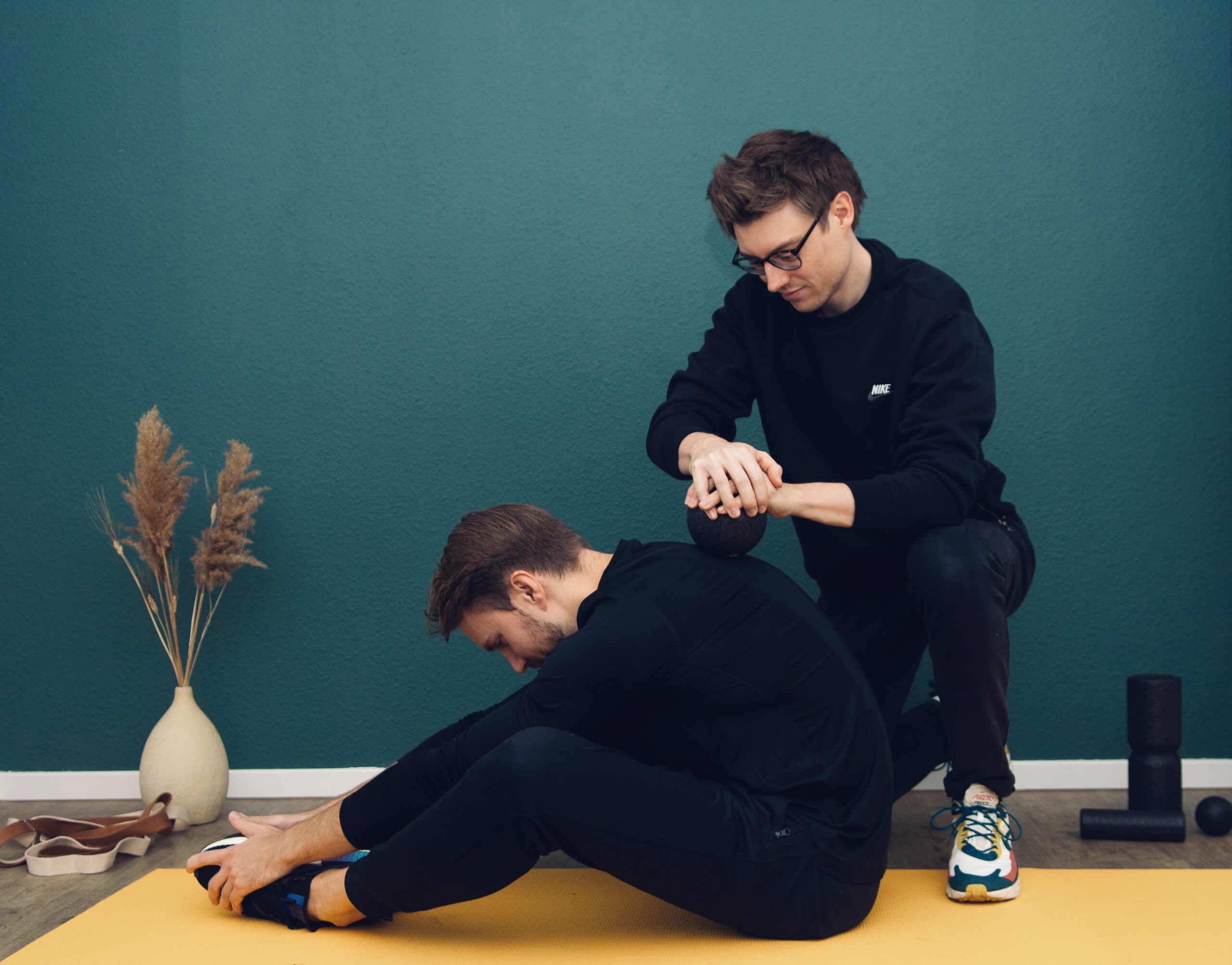
causation of pain -Agonist and antagonist
But how does this pain arise?
The pectoral muscles sit at the front of the upper body and are connected to the shoulders. Anyone who has ever exercised the chest knows that the soreness usually occurs at the ends, i.e. between the chest and the shoulder. Now, when the chest grows through targeted training, it shortens more and more. On the one hand, this looks good at first glance and brings quick results, but on the other hand, the shoulders are pulled further forward. If you don ´ t counteract this with stretching, this trend can no longer be reversed. The shoulders being pulled forward create a hunchback, you have probably seen this several times. But if the muscles shorten in the front, the opponents must somehow lengthen or stretch. Here, as always, the principle of agonists and antagonists comes into play.
Chest and shoulder pain - symptoms
Possible pain no. 1: The antagonists in this case are different back muscles, which have to stretch in an unnatural way. This leads to tension and pain in the back, neck our shoulder area.
Possible pain no. 2: At the same time we don ´ t always want to run with a hunched back, so we try to straighten our shoulders. To do this, we need to contract our back muscles around the shoulder blades to pull our shoulders back. What does this mean for our pectoral muscles? Since they are severely shortened, the are stretched out in an uncomfortable way, which can also lead to pain.
Possible pain no. 3: Now, if we try to balance our posture for an extended period of time, the back muscles will over-acidify. Since they have to contract all the time and without rest there is a lack of time to recover and regenerate. We know this feeling from overworked muscles. So what happens normally? They start burning. This is usually manifested by a burning sensation between the shoulder blades or in the middle back.
This is the reason why it is useless to simply strengthen the back muscles without doing anything else. It will make the back stronger, yes, and maybe it can last longer, but in the end the result is the same. The only difference is that it is usually the intervertebral discs or joints What happens to muscles that have to work too long and too much? They overacidify! And how does that usually feel for you? Right, the muscles burn noticeably and need to be relieved.
our solution against chest and shoulder pain
So what can we do about it?
It's very simple: stretching. We need to rebalance our muscle shortening in order to improve our posture and bring some relaxation for the muscles. If we do some stretching exercises against the shortening of the pectoral muscles, the shoulders automatically go back, the pectoral muscles lengthen and the back muscles do not have to contract all the time so that they get some relaxation. In this way, we manage to relieve all three types of pain in the long term or, in the best case, to get rid of them.
However, stretching is only part of the solution. Should you continue to go to the gym and exercise your chest, you must also pay attention to the execution of your exercises. It ´ s best to perform the movement as wide and full as possible. You should not only pump up the muscles with short movements, but pay attention to a clean, full exercise execution, where you may even go into the negative range to stretch the pectoral muscles at the same time already slightly.
Before beginning any exercises provided on this website, it is advised to consult a health professional, such as a physical therapist or chiropractor.
The exercise instruction and advice presented are in no way intended as a substitute for medical consultation. As with any exercise program, if at any point during your workout you begin to feel faint, dizzy, or have physical discomfort, you should stop immediately and consult a physician or doctor.
EXERCISES FOR shoulder blade pain
We focus on exercises that open up the chest and stretch the chest muscles. As always, it is very important to hold this position for 1.5-2 minutes to create real relief.
workouts
Total Exercise Time
An apartment corner
workout mat
STEP 1
Stand in a corner of your home and spread your arms by straightening your elbows as much as possible.
Raise your arms so your hands are at face level. Keep your upper body straight.
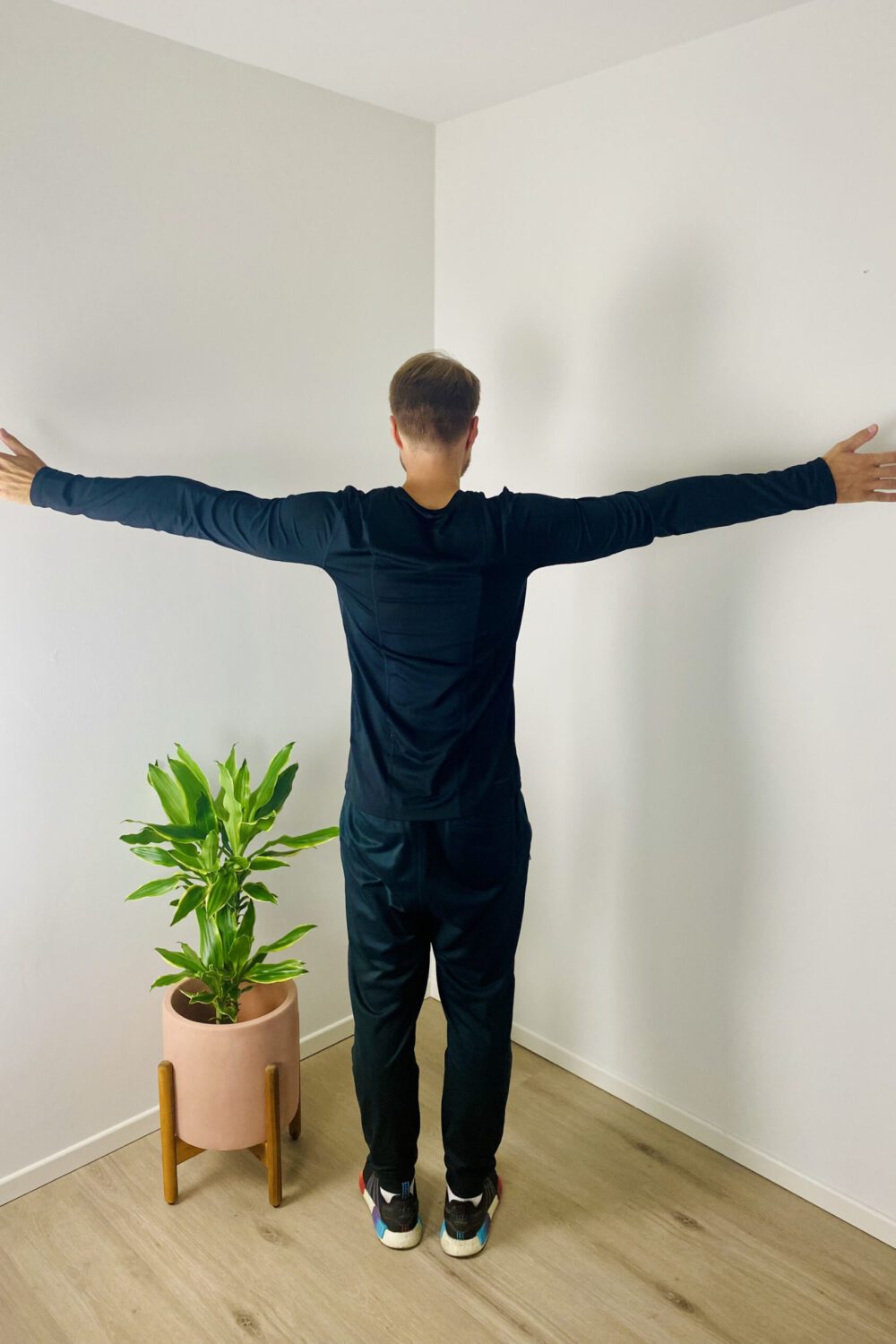
STEP 2
Lean your upper body toward the wall until you feel a stretch in your chest muscles, shoulders, arms, and even elbows.
Stay in this position for 1.5 - 2 minutes.
It is important that you stretch your arms and only go as far as you can without pain. The rule here is always: a stretching pain is good, but as soon as you have to hold your breath or bite your teeth, it is too much. You can do even more stretching if you tilt your upper body slightly toward the corner.
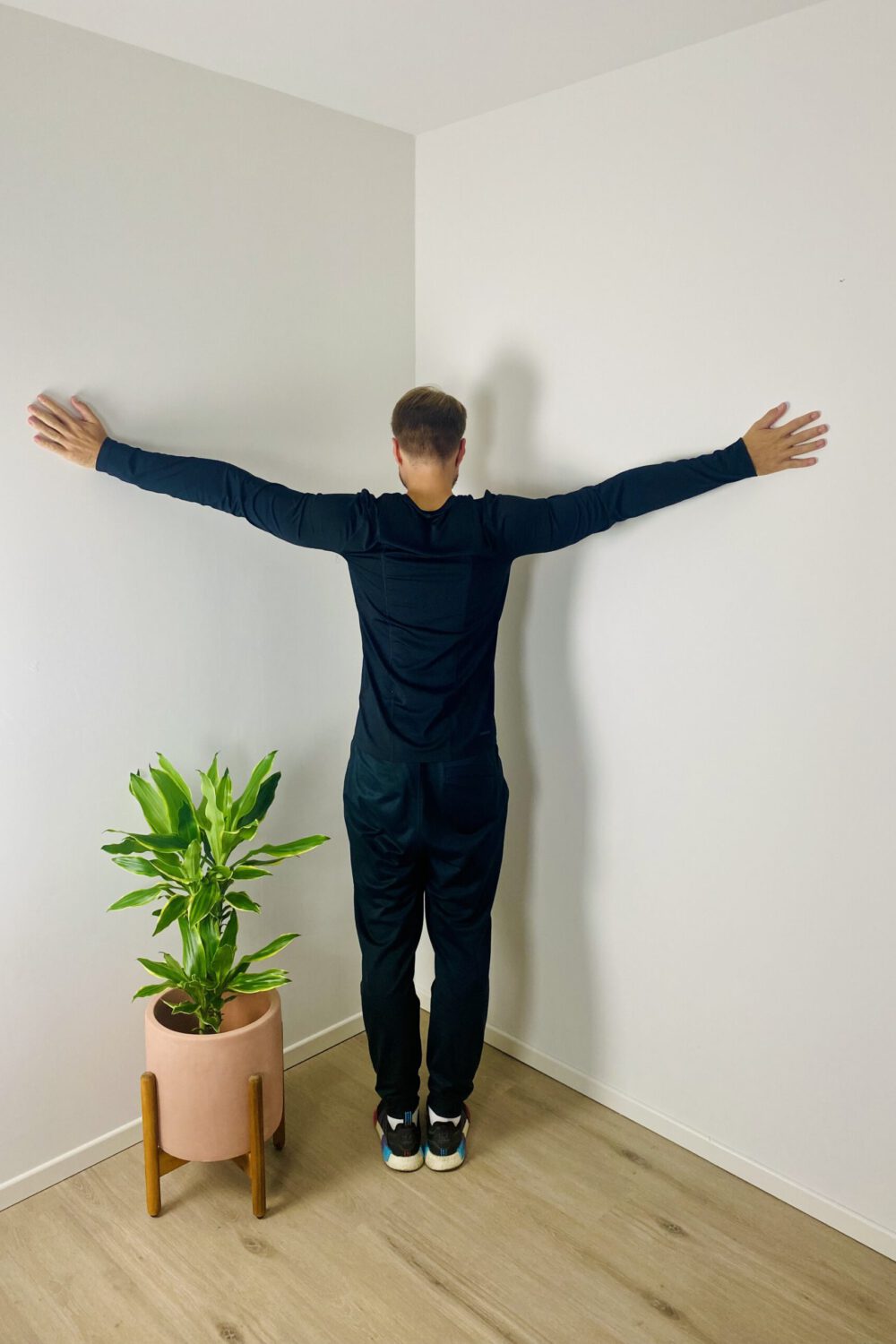
STEP 1
Lie on your stomach and bend your left arm 90 degrees. Turn your head to the right.
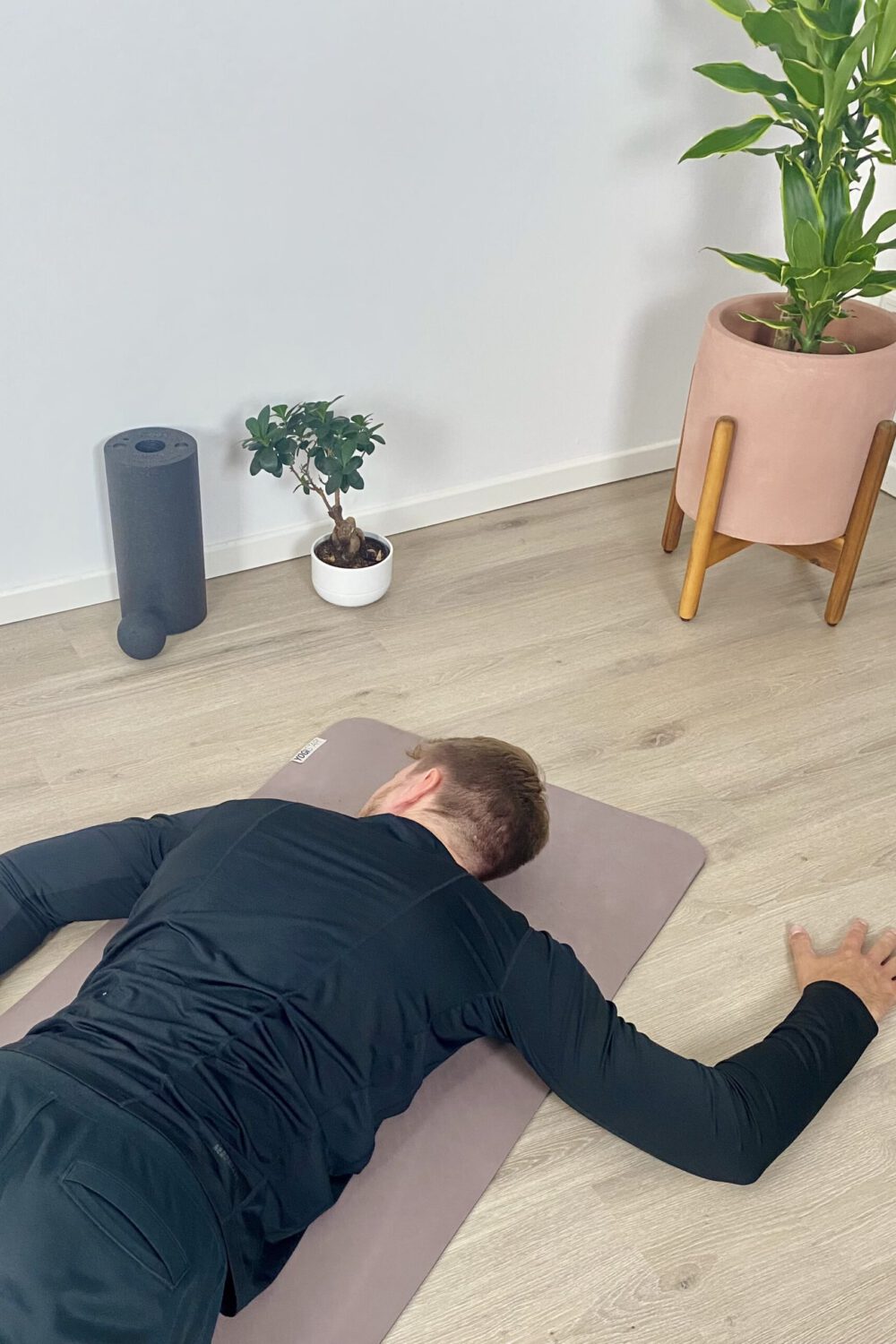
STEP 2
Push yourself up with your right arm. Rotate your hips with it but leave your left arm in the same position as before.
Feel the stretch in your chest and left shoulder.
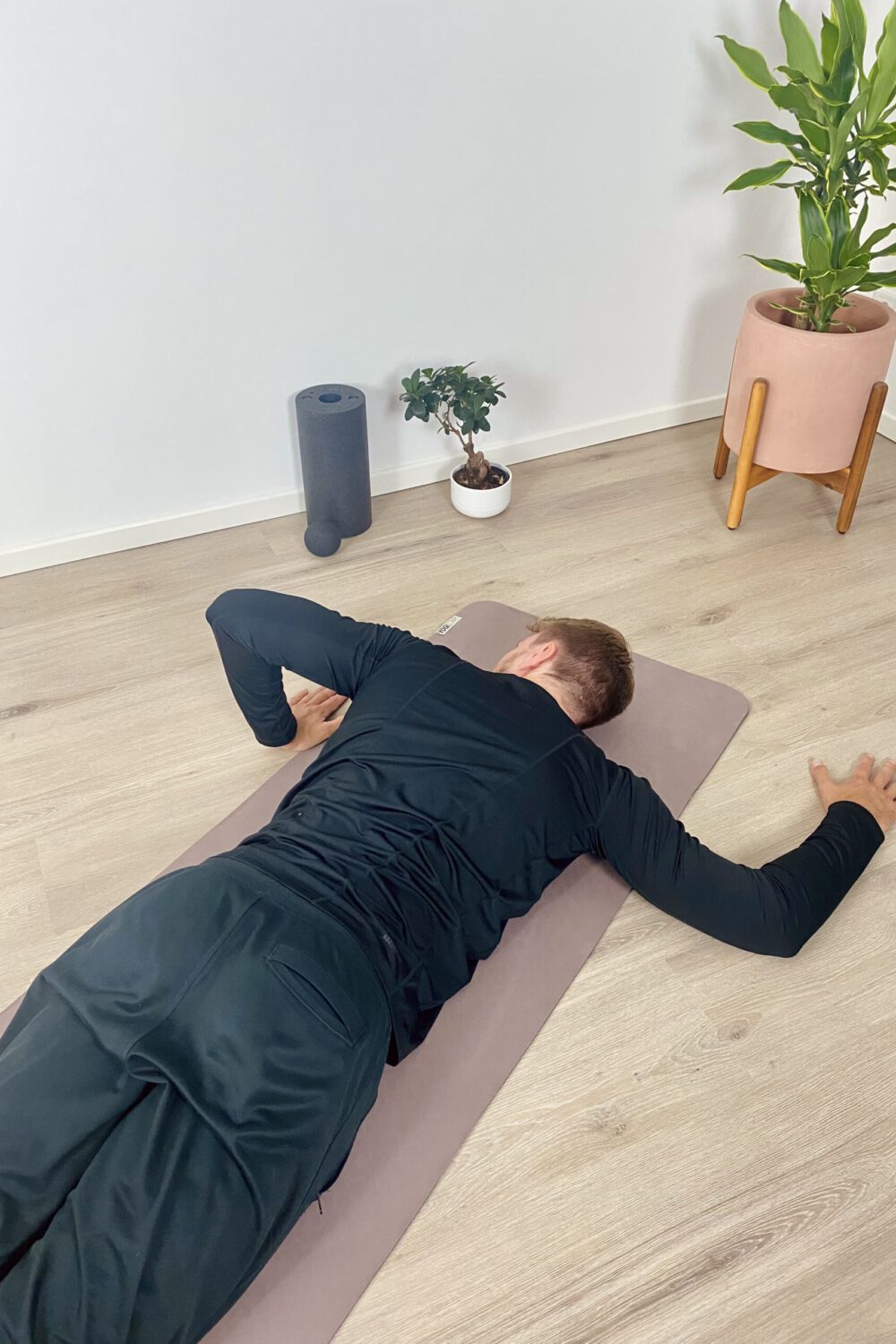
STEP 3
Push yourself as far into the stretch as you need. You can go further into the stretch by pulling your left leg as far out as possible. Hold this position for at least 60 seconds.
STEP 4
Do the same with the other side.
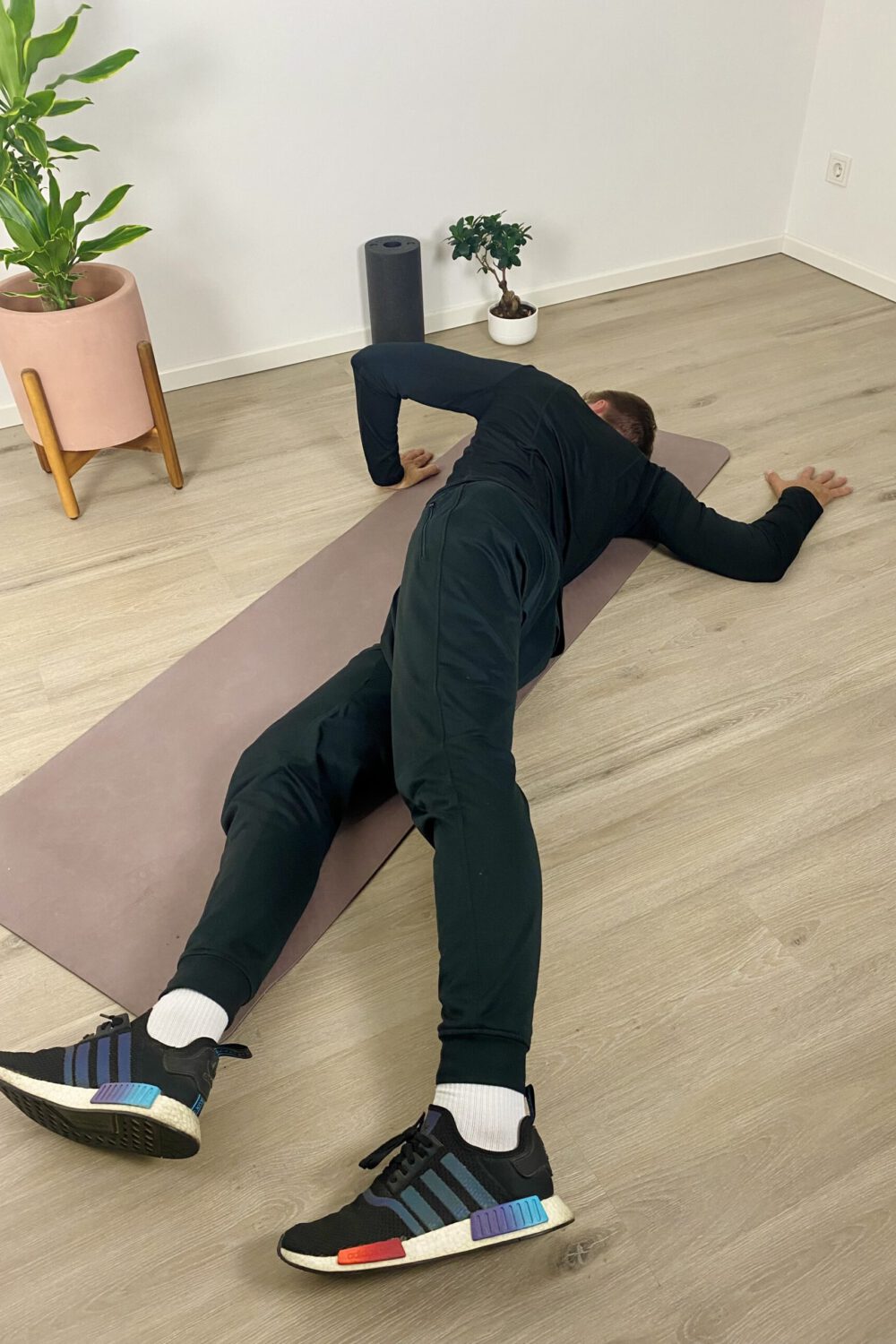
Find out who we are and why we think that a pain-free life is possible for everyone!